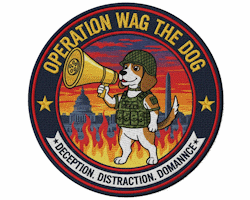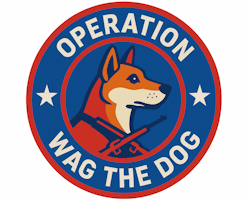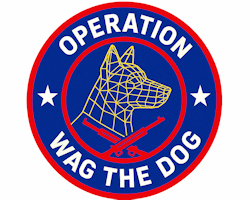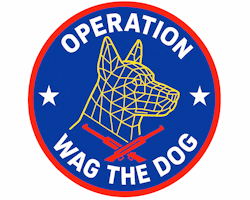Wag the Dog
 The movie "Wag the Dog" is a 1997 political satire film directed by Barry Levinson. A fake war against Albania is swiftly fabricated to makes sure the American public forgets about sexual allegations against the President, and is also given the chance to admire the President’s resolve during a national security crisis.
The movie "Wag the Dog" is a 1997 political satire film directed by Barry Levinson. A fake war against Albania is swiftly fabricated to makes sure the American public forgets about sexual allegations against the President, and is also given the chance to admire the President’s resolve during a national security crisis.
The movie stars Dustin Hoffman and Robert De Niro and tells the story of a spin doctor and a Hollywood producer who fabricate a fake war with Albania to distract the American public from a presidential sex scandal just before an election. The film's title comes from the expression "the tail wagging the dog," meaning a small or unimportant part controlling the whole - in this case, a manufactured media spectacle driving real political outcomes.
The movie explores media manipulation, the construction of reality through television and news coverage, and how public perception can be manufactured. It shows how Hollywood-style production techniques could theoretically be used to create convincing false narratives for political purposes. The film was particularly notable for its timing - it was released in December 1997, just weeks before the Monica Lewinsky scandal broke in January 1998, leading to eerie comparisons between the film's plot and real events, especially when the U.S. launched missile strikes against Sudan and Afghanistan in August 1998 during the height of the scandal. The term "wag the dog" has since entered popular political discourse as shorthand for when a leader might use military action or create international incidents to distract from domestic problems.
Days before re-election, the President is caught in a sex scandal with a minor. Spin doctor Conrad Brean (De Niro) and Hollywood producer Stanley Motss (Hoffman) have less than two weeks to bury the story. Their solution: fabricate a war with Albania that exists only on television screens. They successfully manipulate the media cycle, create a fake hero, stage memorials, and manufacture patriotic fervor - all through pure media production. The "war" never happens except as a television event, yet it dominates public consciousness and saves the presidency. Video Production: In 1997, they filmed a fake refugee fleeing in a studio with a green screen. Today, this would be exponentially easier and more convincing with AI video generation, deepfakes, and real-time CGI that can create photorealistic war footage indistinguishable from reality.
 Social Media Amplification: The film relied on traditional news networks. In 2025, the operation would weaponize TikTok, X, Instagram, and YouTube with coordinated bot networks, influencer campaigns, and algorithmic manipulation to make #AlbaniaWar trend organically within hours.
Social Media Amplification: The film relied on traditional news networks. In 2025, the operation would weaponize TikTok, X, Instagram, and YouTube with coordinated bot networks, influencer campaigns, and algorithmic manipulation to make #AlbaniaWar trend organically within hours.
Manufactured Grassroots: They created a folk song and yellow ribbon campaign. Modern equivalents would be viral challenges, AI-generated patriotic anthems, coordinated hashtag movements, and seemingly authentic user-generated content - all astroturfed.
The Backstory: They invented a hero named "Old Shoe" complete with false history. Today's version would include fabricated social media profiles with years of backdated posts, AI-generated childhood photos, fake school records inserted into databases, and manufactured "friends" posting memories.
News Manipulation: They fed stories to compliant media. Now they'd exploit the fragmented media ecosystem - planting stories across partisan outlets, using deep-faked "leaked footage," and creating information cascades where each outlet cites another, building false legitimacy.
Credibility Laundering: Anonymous intelligence "leaks," doctored satellite imagery, fake expert analysis from AI-generated think tank reports, and coordinated statements from purchased bot accounts posing as foreign witnesses.
The 2025 Difference: What required a Hollywood studio in 1997 could now be executed from a laptop. The barrier isn't technical capability - it's the fragmented, skeptical information environment where everything is simultaneously believable and questionable, making consensus reality harder to establish but also making fabricated realities easier to sustain within echo chambers.
 Eleftheria Thanouli noted " Wag the Dog could be regarded as a limit case in contemporary American cinema for the ways in which it confronts us with a standard set of quandaries that emerge every time we seek to define the boundaries between cinema and reality and we strive to understand how people, either as artists or viewers, are expected to handle them.... Ever since the time of Aristotle and Plato, the thoughts regarding the role of art have centred on its aspired relation to physical reality. Whether art should imitate the real world or whether it should creatively add to it, is the core dilemma in the theory of all art forms. Unlike painting, poetry or music, however, cinema seemed to boast a unique bond to reality, a bond that would stir even more divisive views regarding its purported destiny. The technical capacity of the moving images to record real life so faithfully was a mixed blessing for the new medium to the extent that it immediately triggered antithetical approaches both in filmmaking practices and in theoretical writings."
Eleftheria Thanouli noted " Wag the Dog could be regarded as a limit case in contemporary American cinema for the ways in which it confronts us with a standard set of quandaries that emerge every time we seek to define the boundaries between cinema and reality and we strive to understand how people, either as artists or viewers, are expected to handle them.... Ever since the time of Aristotle and Plato, the thoughts regarding the role of art have centred on its aspired relation to physical reality. Whether art should imitate the real world or whether it should creatively add to it, is the core dilemma in the theory of all art forms. Unlike painting, poetry or music, however, cinema seemed to boast a unique bond to reality, a bond that would stir even more divisive views regarding its purported destiny. The technical capacity of the moving images to record real life so faithfully was a mixed blessing for the new medium to the extent that it immediately triggered antithetical approaches both in filmmaking practices and in theoretical writings."
"The realist tradition in film theory has located cinema’s essence in its technical ability to record real life more accurately than any other medium in cultural history.... In the quest of the cinematic essence, the anti-realist camp brought attention to other functions of the medium, refuting the realists’ claims about the desired connection of film with reality.... where the conditions of reproduction serve in some way to mould the object.’7 In this line of thought, cinema could only become an art provided that it relieved itself from its reproductive ability and focused on its formative potential....
" With the advent of digital technology and the consequent changes in cinema’s recording capacities, contemporary film theory was forced to review all the questions that classical theory had seemed to tackle....
"Wag the Dog was loosely based on the novel American Hero written by Larry Beinhart in 1993.20 In his book, Beinhart combined real and fictional elements in order to present the story of an American president who stages a war in order to get re-elected. The name of that president was George H. W. Bush and the war was called Operation Desert Storm, also known as the Gulf War. From within a fictional framework, Beinhart put forward his own theory that the Gulf War was merely another communication scheme devised by Lee Atwater..."
 Thomas L. Friedman, the New York Times columnist, made the "Wag the Dog" comparison in an article published in July 2020 Friedman: Trump is starting a wag-the-dog war at home. Friedman wrote that while some presidents "wag the dog" by starting a war abroad when they get into trouble before an election, Donald Trump seemed ready to "wag the dog by starting a war at home." He was referring to Trump's threats to send federal forces into U.S. cities where local mayors hadn't invited them Friedman: Trump is starting a wag-the-dog war at home.
Thomas L. Friedman, the New York Times columnist, made the "Wag the Dog" comparison in an article published in July 2020 Friedman: Trump is starting a wag-the-dog war at home. Friedman wrote that while some presidents "wag the dog" by starting a war abroad when they get into trouble before an election, Donald Trump seemed ready to "wag the dog by starting a war at home." He was referring to Trump's threats to send federal forces into U.S. cities where local mayors hadn't invited them Friedman: Trump is starting a wag-the-dog war at home.
Friedman also compared Trump's approach to that of Syrian President Bashar Assad in 2011, suggesting that Trump wanted to transform peaceful protests into conflicts with "radicals" so he could play the "law-and-order president" Friedman: Trump is starting a wag-the-dog war at home.
Commentary discussing this comparison was from 2020, related to Trump's first term and the protests that occurred during that period. The more reent news about Trump's "war on cities" involved his deployments of National Guard troops to cities like Portland, Chicago, and others in 2025, which sparked similar concerns about federal overreach.
The 2025 critics made arguments very similar to the "Wag the Dog" thesis — that Trump was manufacturing or exaggerating crises for political purposes — but they were not initially using that specific movie reference.
|
NEWSLETTER
|
| Join the GlobalSecurity.org mailing list |
|
|
|

